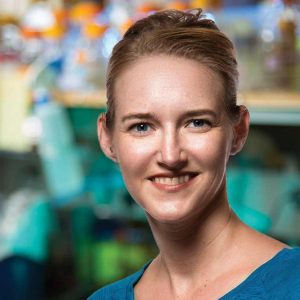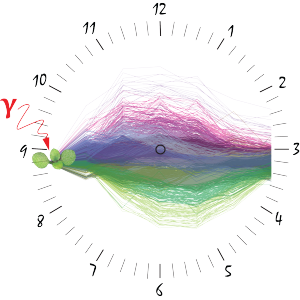
December 14, 2018
Salk scientists reveal a complex network of genes that helps plants cope with DNA damage
LA JOLLA—When a building is damaged, a general contractor often oversees various subcontractors—framers, electricians, plumbers and drywall hangers—to ensure repairs are done in the correct order and on time.
Similarly, when DNA is damaged, a molecular general contractor oversees a network of genetic subcontractors to ensure that the diverse cellular tasks needed to protect and repair the genome are carried out correctly and on time.
Scientists have known for some time that a master gene named SOG1 acts like a general contractor for repair, coordinating with various genetic subcontractors of the plant cell to mount an effective DNA damage response. But, it wasn’t clear which specific genes were among the subcontractors, nor how SOG1 interacted with them to oversee the DNA damage response.

Click here for a high-resolution image
Credit: Salk Institute
Now, researchers at the Salk Institute report which genes are turned on or off, and in which order, to orchestrate the cellular processes required to protect and repair the genome in response to DNA damage. The research, which appeared in the journal Proceedings of the National Academy of Sciences during the week of October 10, 2018, reveals the genetic framework controlling a complex biological process that has broad implications for understanding how plants in particular, and organisms in general, cope with DNA damage to ensure long-term health and fitness.
“Just as a building with structural damage can be unsafe, cells with DNA damage that goes unnoticed or unrepaired can be dangerous,” says Assistant Professor Julie Law, the senior author of the paper. “However, the timing and overall coordination of events occurring after the detection of damaged DNA remain poorly understood. Is SOG1 acting like a micromanager, directly pointing each subcontractor to a task, or does it have a more hands-off role? This paper brings us one step closer to understanding how the response to DNA damage is coordinated over time to maintain genome stability.”
To better understand the dynamics of gene regulation throughout the DNA damage response and to determine the direct roles of SOG1 in this response, Law and her team conducted a series of experiments in Arabidopsis thaliana, a weed commonly used for genetics research. They grew two sets of Arabidopsis seedlings: one set was normal; the other set contained a mutated version of the SOG1 gene, rendering it nonfunctional.

Click here for a high-resolution image
Credit: Salk Institute
The team exposed both sets of plants to strong ionizing radiation to generate DNA double-strand breaks. Then they analyzed gene expression changes compared to non-irradiated controls at six time points ranging from 20 minutes to 24 hours. They found the expression of approximately 2,400 genes went up or down in response to DNA damage during that time period, almost all of which depended on SOG1’s presence. However, they found that only approximately 200—or about 8 percent—were directly activated by SOG1, which revealed the first layer of a complex gene regulation network and showed SOG1 to be taking a more “hands off” overseer role.
To understand what these approximately 2,400 genes were doing, Law’s group fed their data into a software program called DREM, which identifies genes with similar patterns of expression over the entire 24-hour period of the study. This resulted in the identification of 11 groups of genes that act on different time scales and play known or predicted roles in different aspects of the plants’ response to DNA damage.
“It’s exciting to get more clarity on the specific gene networks and subnetworks involved in the DNA damage response, as well as their timing, which had not been done before,” says Law.
In addition to informing strategies to improve crop health by maintaining genome stability, this work may also shed light on conserved aspects of the DNA damage response in other organisms, as there are many parallels between SOG1 and a gene in animals that has a similar “general contractor” function—the p53 gene, a tumor suppressor known for its role in combating DNA damage to prevent cancer.
Next, the lab plans to study the roles of new factors implicated in the DNA damage response based on their expression profiles and to continue exploring the network of genes being directly or indirectly controlled by SOG1.
Other authors on the paper included Clara Bourbousse and Neeraja Vegesna of Salk.
The work was funded by the Rita Allen Foundation, the Hearst Foundation, a Catharina Foundation Fellowship, the Jesse and Caryl Philips Foundation, the Glenn Foundation for Medical Research, the Chapman Foundation and the Helmsley Charitable Trust.
JOURNAL
Proceedings of the National Academy of Sciences
AUTHORS
Clara Bourbousse, Neeraja Vegesna, and Julie A. Law
Office of Communications
Tel: (858) 453-4100
press@salk.edu
Unlocking the secrets of life itself is the driving force behind the Salk Institute. Our team of world-class, award-winning scientists pushes the boundaries of knowledge in areas such as neuroscience, cancer research, aging, immunobiology, plant biology, computational biology and more. Founded by Jonas Salk, developer of the first safe and effective polio vaccine, the Institute is an independent, nonprofit research organization and architectural landmark: small by choice, intimate by nature, and fearless in the face of any challenge.